
Mold and mildew can cause damage to your roof and attic space. Over time, they can even compromise structural members and cause structural components to decay. The National Bureau of Standards estimates that a home with four occupants produces two to three gallons of water vapor a day. Moisture is also migrated from basements and crawl spaces, especially if these lack vapor barriers. Moisture then migrates to wall and ceiling cavities where it can cause a multitude of issues.
One way to deal with moisture in your attic is through roof ventilation. Attic and roof spaces need to breathe or they will start develop mildew and rot. Hot, moist air from your home rises up and into your attic and condenses. When your attic insulation gets wet, it can lose R-value which will mean you pay higher energy bills trying to heat and cool your home.
The best way to ensure that attic and roof moisture has somewhere to go is to provide adequate ventilation. The best way to ventilate an attic is to have soffit ventilation and ventilation at the ridge, or as close to the ridge as possible. Half the ventilation should be along the eves and half at the ridge. Vents should have a stamp on them indicating the “net free air/area” in square inches. Most building codes require 1 square foot of net free air for every 300 square feet of attic area with the net free air divided evenly between ridge and eves. But that would also depend on your climate zone and whether you have a vapor retarder. Check your climate zone and local building codes for more accurate ventilation information. Power vents work but they also suck air into the attic. Gable vents work but are not as efficient as they tend to draw air from around them and therefore some areas may not be adequately vented.
Ensure that your insulation isn’t blocking any vents. Be sure to add baffles if required, especially when adding additional insulation to the attic as some homeowners do in the fall.
Attic ventilation also keeps your roof cooler in the summer which means that shingles won’t blister and you get more life out of your roof.
Make sure your roof vents are protected from animals. Squirrels and other animals like to chew through attic vents and damage the flashing. Investing in adequate attic ventilation will always stand you in good stead.
